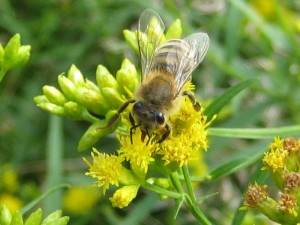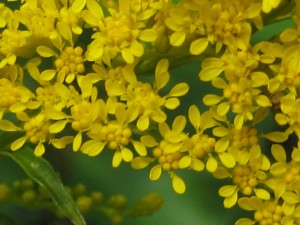A hungry predator crawls through a leafy jungle. Slow cautious movements make no sound. The well-camouflaged predator waits, motionless. Powerful forelegs stretch wide to grab its unwary prey.
A single goldenrod plant is a complex habitat, the leaves, stems, and flowers providing food and shelter for a bewildering variety of strange, hidden creatures. Each goldenrod plant has thousands of tiny blossoms crammed together, their nectar providing a vital late-summer source of nutrition for butterflies, moths and bees.
Take a safari along the length of a goldenrod plant! Perhaps you’ll see a butterfly clinging to the stalk, flapping rainbow wings to keep its balance. Watch the butterfly’s long, thread-like tongue uncurl and poke deep into the yellow blooms, siphoning up high-energy nectar.
Since so many insects come to feast on goldenrod nectar, the flowers are a rich hunting ground for predators big and small. Look for tiny crab spiders, which can change color—they’re white on Queen Anne’s lace, green on leaves, and turn yellow to match goldenrod flowers. Crab spiders don’t spin webs, they hide in the blossoms with forelegs outstretched. They’ll wait for hours or days without moving, until a nectar-sipping bug comes within reach.
Ambush bugs are ferocious predators that can capture prey ten times their size. They lurk just beneath the petals, like sharks beneath the water. When an insect leg or tongue comes close, the ambush bug strikes! Like spiders, the ambush bug doesn’t eat its prey—its long beak pokes a hole in its victim and sucks out the juices.
Along the stalk, look for strange triangular-shaped bugs called treehoppers. They pierce the goldenrod leaves with sharp mouthparts and suck out the sap. Jagged holes in the leaves show where beetles and caterpillars have been munching. What looks like a drop of ink on a leaf is called a blister gall. Inside the black spot is a midge larva. Or you might see a narrow line, like someone scribbled on the leaf with a white pencil. Tiny insect larvae called leaf miners chew their way through the leaf, leaving a wandering trail behind them.
All this insect life makes goldenrod a fruitful hunting ground. Larger bugs like praying mantises and walking sticks prowl the golden jungle, as well as dozens of species of birds like sparrows and chickadees.
Each species of goldenrod hosts its own unique food web. There are more than a hundred goldenrod (Solidago) species: sweet goldenrod, early goldenrod, lance-leaved goldenrod, seaside goldenrod, bog goldenrod… Trying to identify them is a botanist’s nightmare, but insects like the Goldenrod Gall Fly (Eurosta solidaginis) manage it easily. Special chemical receptors, like taste buds in the insect’s feet, reveal which species is which. Gall flies prefer to lay eggs on Canada goldenrod (Solidago canadensis), although they’ll also use other kinds.
If you feel a round bump on a goldenrod stalk, you’ve found a ball gall—the snug home of the gall fly larva. In spring, a female gall fly lays a single egg inside the goldenrod stem. The egg hatches and the larva begins to eat the plant. The insect’s saliva contains growth hormones which cause the stem to swell and create a weatherproof home around the larva. The little insect spends many cozy months inside the gall, surrounded by food
But the larva isn’t always safe in its round home. Wasps can pierce the gall with a long ovipositor (egg-laying tube) and lay eggs inside the gall. When the eggs hatch, the young wasps will feed on the gall fly. Woodpeckers and chickadees will peck a hole into the gall to devour the tasty larvae.
Predators and prey. Life and death. All are woven together in the goldenrod jungle.






A interesting thing to observe with goldenrod ball gall is the escape tunnel the larva chews before it pupates. Since the mouthparts of the adult fly is incapable of chewing its way out of the gall the larva has to chew an escape tunnel. If you cut open a call in late winter after the larva has entered its pupal stage you can observe this tunnel. If you hold the gall up to the light you can peer down the tunnel and you will see what the adult fly would see upon emerging from its pupa skin. It is literally “a light at the end of the tunnel”!
cool!